The headline in this round of NPLW fixtures saw two of the league’s more tactically interesting teams in Calder United and South Melbourne. South has demonstrated an ability in recent years to change systems effectively, while Calder stands out with their fluid 4-4-2 diamond system.
How they lined up
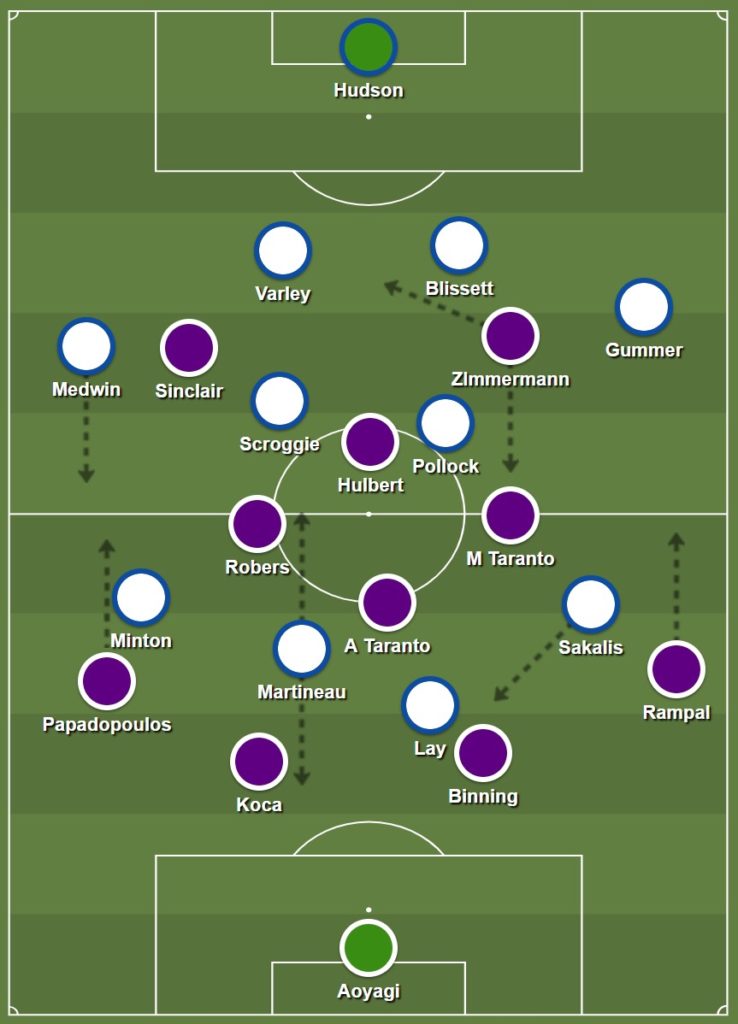 Calder lined up as expected. Catherine Zimmermann and Aleksandra Sinclair formed the front two, with both staying high up the field and in the channels to exploit the spaces left behind by Aimee Medwin and Alexandra Gummer when the South fullbacks ventured forward. Emily Hulbert featured at the tip of the diamond, Adriana Taranto at the base, Emma Robers and Melissa Taranto shuttling either side, although all four players were comfortable rotating through the diamond.
Calder lined up as expected. Catherine Zimmermann and Aleksandra Sinclair formed the front two, with both staying high up the field and in the channels to exploit the spaces left behind by Aimee Medwin and Alexandra Gummer when the South fullbacks ventured forward. Emily Hulbert featured at the tip of the diamond, Adriana Taranto at the base, Emma Robers and Melissa Taranto shuttling either side, although all four players were comfortable rotating through the diamond.
In a league where the majority of teams play 4-3-3 or 4-2-3-1, there are several benefits in playing a 4-4-2 diamond. A 4-4-2 diamond creates a numerical overload in the centre of the pitch, making it easier to keep the ball, easier to defend this zone, and easier to play out from the back with more central options.
To counteract this, South lined up in what appeared to be a flat 4-2-4, but was effectively a variant of a 4-2-3-1. Best known as midfielders, Cindy Lay and Natalie Martineau lined up in centre forward positions, with the latter being tasked with creating 4v4 in midfield against Calder’s diamond as well as breaking forward to provide attacking support. Another notable but logical change was Chelsea Blissett (a left back/winger) playing at centreback, with her pace helping defend the movement of Zimmermann. The adaptability of Lay, Martineau, and Blissett demonstrates the underlying reason for South’s aforementioned tactical unpredictability.
First Half
With the temperature 35°C at kickoff, the game started slowly. Calder looked to take the initiative by dominating possession in the opening minutes, with South happy to sit back in a mid-block and allowing the Calder centrebacks time and space on the ball until they approached the middle third.
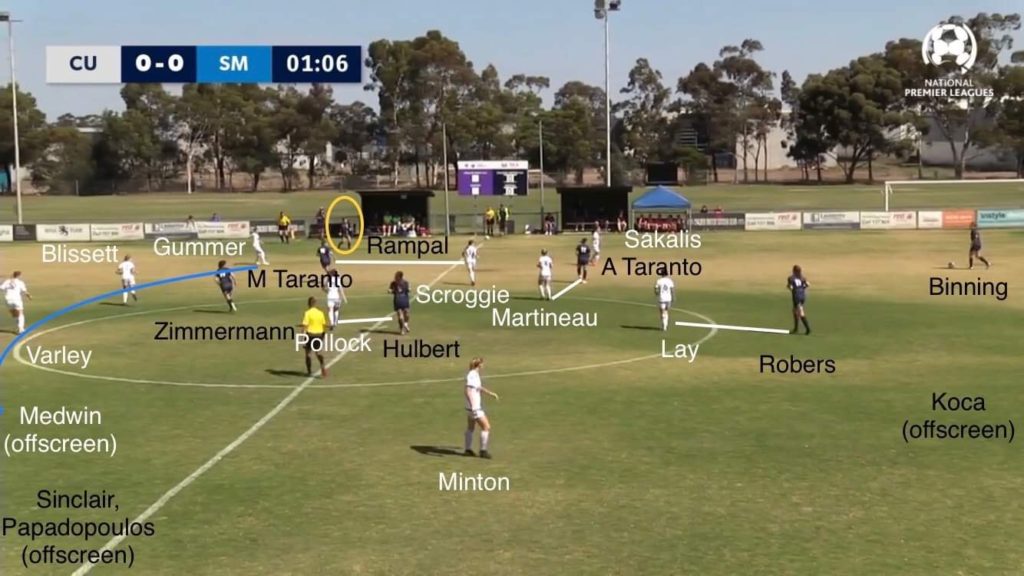
One downside to the 4-4-2 diamond is the lack of attacking width, unless the fullbacks go forward or the two strikers split into the wide areas. With Calder’s very attack-minded fullbacks and South’s wingers not consistently tracking them, Calder to created 4v4 situations in the South backline.
This is how the first goal was scored – a quick switch of play released Marie Rampal on the right, with Sofia Sakalis slow to track her. This forced Gummer to defend Rampal, leaving Blissett 1v1 against Zimmermann. Darting into the space that opened up behind Gummer, Zimmermann received Rampal’s pass and set up Melissa Taranto to score from the edge of the area.
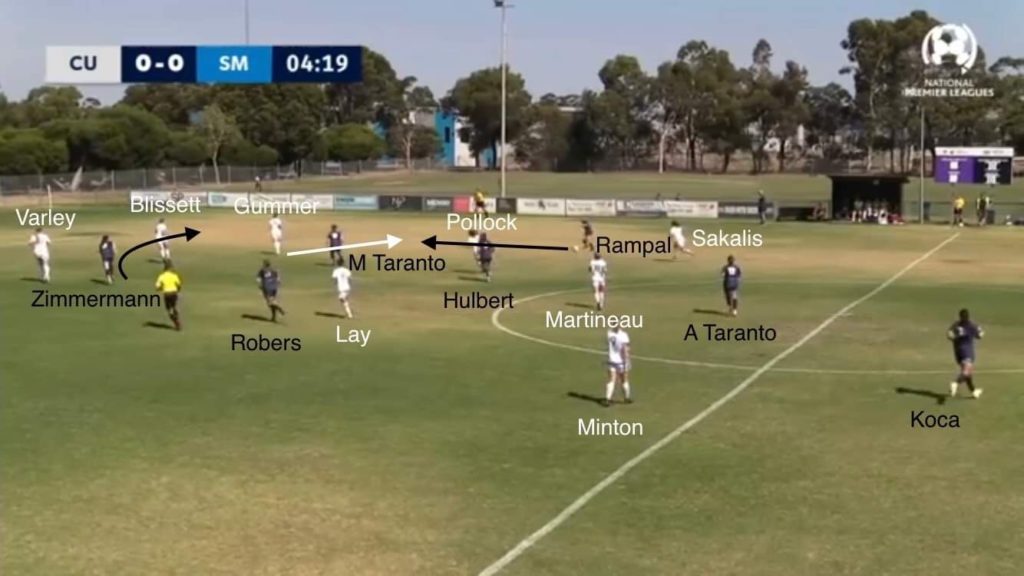
The early goal forced South to attack more, however their numerical disadvantage in midfield discouraged their usual buildup through midfield and forced them to play long balls for Kelsey Minton and Sakalis to chase. This was a reasonable strategy, as the advanced positioning of the Calder fullbacks meant that Rachel Binning and Gulcan Koca had to cover the width of the field.
Unfortunately, the lack of a designated striker meant that there was minimal support for Minton and Sakalis. As the two most advanced South midfielders, Lay and particularly Martineau were responsible for providing this support, but this left them with a dilemma. By pushing up, they risked leaving Jamie Pollock and Leah Scroggie outnumbered against Calder’s midfield. While Martineau’s remarkable stamina allows her to effectively play two positions at the same time, in the oppressive heat it was too much of an ask. This uncertainty on South’s part meant Calder were generally able to easily defend South counterattacks.
Martineau’s injury in the 22nd minute deprived South of vital energy in midfield and counter-attacking pace, although it did lead to South becoming more structured. Maryam Anvari came onto the right wing, Minton moved into the centre forward position, and Sakalis remained on the left. While South were a fluid 4-2-3-1 with Martineau on the pitch, without her they had a more defined central triangle with Lay as the number 10 supported by Scroggie and Pollock. This meant South had more support in attacking areas when counter-attacking with early balls behind Rampal and Papadopoulos.
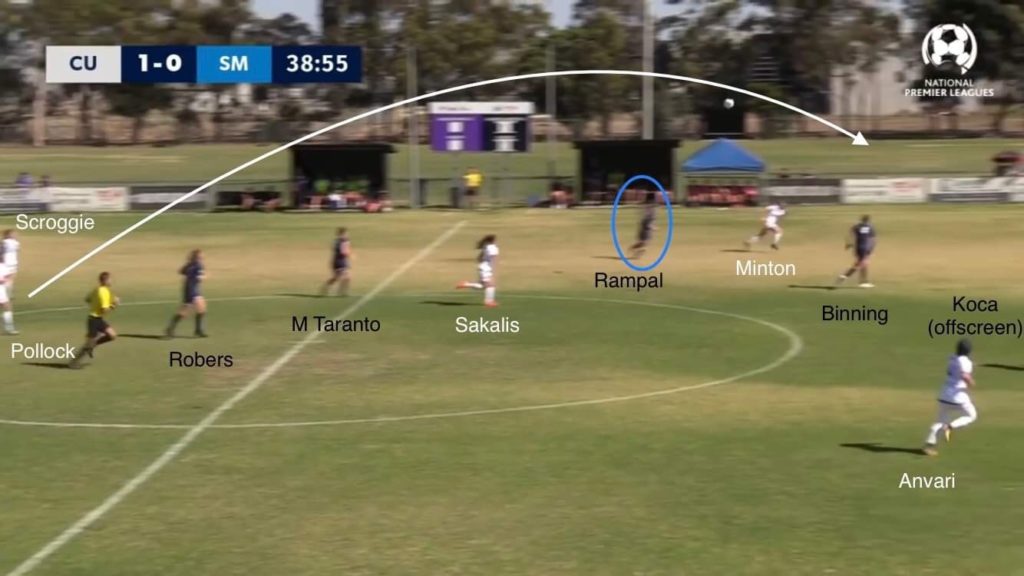
Second half
Calder brought on Alana Burn at half-time for Robers, while South made no substitutions but rearranged their lineup. Keeping the 4-2-3-1, Minton went back to the right wing, Anvari moved to the left wing, Sakalis joined Lay and Scroggie in midfield, and Pollock moved to centre forward.
A goal down and needing to chase the game, South were noticeably more aggressive and cohesive in their pressing. Pollock energetically closed down the Calder centrebacks, while Anvari and Minton tucked in from the wings to squeeze the central zone to minimise the numerical advantage Calder had there.
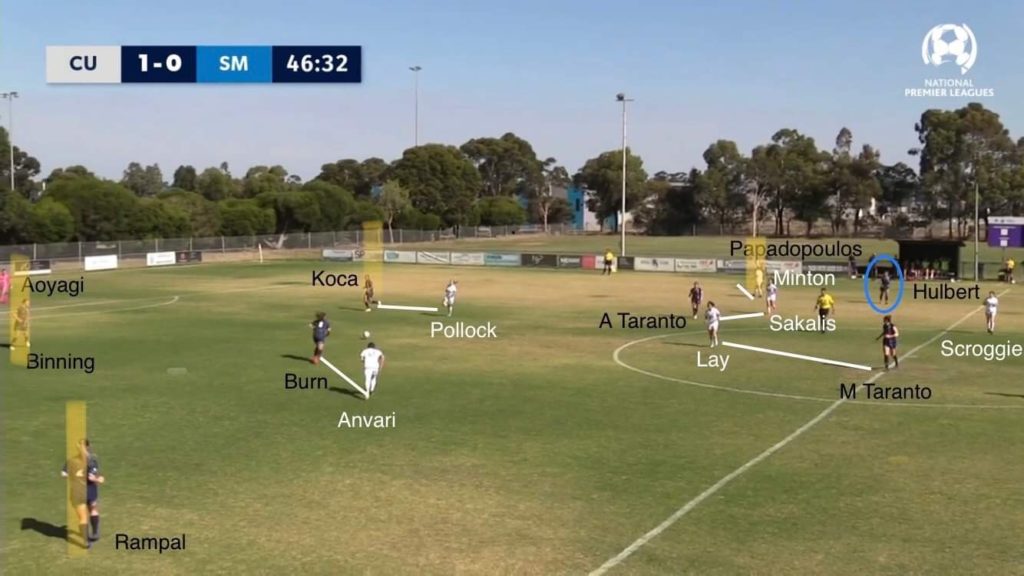
However, the heat meant South weren’t able to maintain this intensity, and within a minute it was 2-0.
The difference in physical condition was perfectly illustrated in the buildup for the second goal. Pollock and Sakalis were slow to recover after Lay lost possession, leaving Scroggie 1v2 against the Taranto twins. This forced Varley to step out, and clever rotation by Zimmermann and Sinclair pulled the remaining South defenders out of position, allowing Sinclair to receive Adriana Taranto’s pass and set Melissa Taranto up to score. Similar to the first goal, Calder’s 4v3 midfield overload meant that a midfielder was free to shoot.
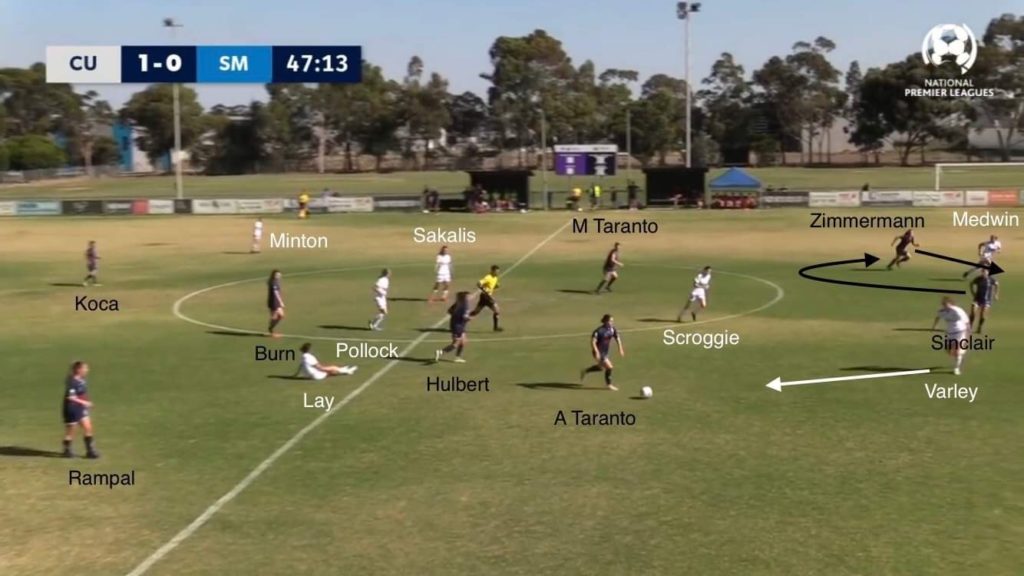 It was notable that the heat did not seem to affect Calder as much as it did South – the latter were doing far more chasing after the ball, and Calder’s conditioning program appears designed to have them peak earlier than other teams (e.g. winning the Community Shield in 2017-2019). Consequently, the second goal effectively killed the game, as South looked tired and out of ideas, meaning Calder could afford to conserve energy by settling in possession as in the first half.
It was notable that the heat did not seem to affect Calder as much as it did South – the latter were doing far more chasing after the ball, and Calder’s conditioning program appears designed to have them peak earlier than other teams (e.g. winning the Community Shield in 2017-2019). Consequently, the second goal effectively killed the game, as South looked tired and out of ideas, meaning Calder could afford to conserve energy by settling in possession as in the first half.
Over the remainder of the second half, South made several substitutions and moved players around to try change the game, although this worsened their cohesion and made a South comeback even more unlikely. In this period, Emily Rayment came into midfield and then moved to right back, allowing Medwin to move to the right wing; Skye Jensen (normally a centreback) came on at left back, allowing Gummer to move to central midfield; and lastly, Kelsey Quinn (a goalkeeper) came on at centreback, allowing Blissett to move to the left wing.
Meanwhile, Calder’s changes were like-for-like, allowing them to keep the same system and close the game out without much fuss, adding a third goal off a corner in the 81st minute.
Conclusion
The key to stopping Calder is to stop their fullbacks from getting forward. Without width, everything gets funnelled through the centre, making Calder’s attack predictable. However, South were unable to do so, and consequently Calder were able to create overloads on South’s defence for the first two goals.
While the heat no doubt affected the evenness of the contest, there were sufficient moments where South did ask questions of the Calder defence when Rampal and Papadopoulos were caught upfield. Expect opponents to target that area in the coming weeks.
Missed the game? Watch the full replay on YouTube on the NPL Victoria channel.
Chor Lai currently holds an AFC B Licence and is a former Women’s Premier League Reserves and State League 1 Reserves coach with more than 200 games in women’s football across all levels.
Tune in every other week for more analysis on NPLW from Chor.

